|
|
Places in Spain -
Estepa, Andalucia
|
Estepa
is to
be
found
just
off
the
A92
highway,
slightly
above
Malaga
in
Andalucia
and is
a
perfect
stop
over
between
Seville
and
Granada.
Over
recent
years,
Estepa
has
grown
to
accommodate
a
swelling
population
and
the
residential
part
of
Estepa
offers
nothing
for
the
visitor.
The
old
town
however,
offers
a
wealth
of
monuments
and
churches.
The
town
has
retained
its
typical
Andalucian
atmosphere,
very
similar
to
nearby
Antequera.
The
town
is
very
peaceful
and
its a
pleasure
to
walk
the
narrow
streets,
lined
with
white-washed
Andalucian
houses
with
churches
dotted
between.
|
|
|
|
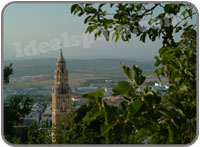
|
| |
|
Estepa
is
surrounded
by
wheat
fields
and
olive
groves.
The
town
is
famous
for
its
olive
oil
and
its
cakes,
made
from
the
local
flour.
The
people
of
Estepa
are
friendly
and
welcome
visitors;
there
are
not
too
many
foreigners
that
make
their
way
there.
For
the
best
view
of the
town,
head
for
the
castle
and
the
mirador.
|
| |
| Low cost car hire in this part of Spain - Instant quotes, online booking and guaranteed reservations. Access to all the top car hire companies in Spain |
|
|
|
There
are
several
important
monuments
to
visit
in
Estepa
and
several
beautiful
churches.
Here
are
just a
few of
them.
|
|
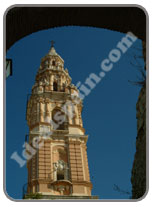 |
The
Victoria
Tower
This
tower,
declared
a
National
Monument
in
1955,
is the
only
trace
that
remains
of the
disappeared
church
of "La
Victoria"
which
belonged
to the
convent
of the
Father
Minims
of
this
town.
The
Minim
Friars
arrived
in
Estepa
in
February
1955.Their
arrival
was
sponsored
by the
Marquis
of
Estepa,
Marcos
de
Centurión,
who
had,
as
these
Friars
an
Italian
origin.
They
had a
close
link,
and
the
marquis
donated
wheat
and
money
every
year.
The
convent
and
the
church
of "La
Victoria"
were
characterised
by the
splendour
of the
artistic
works
that
ornamented
the
temple.
The
decadence
that
this
order
underwent
caused
the
collapse
of
their
buildings
that
began
with
the
processes
of
"decloistering"
of the
19th
century.
The
monks
left
Estepa
in
1835.
|
|
The
church
had a
Latin
cross
ground
plan
with
one
only
nave
covered
by a
barrel
vault.
The
presbytery
was
covered
by an
onion
dome.
The
scallops
where
the
dome
lay
had
the
coat
of
arms
of the
marquises
of
Estepa.
The
tower
is
preserved
with
the
same
beauty
and
splendour
of
1760
when
it was
built.
The
church
had to
be
demolished
in
1939,
even
though
it was
not in
ruins.
The
tower
is 40
metres
high
and it
has
five
bodies.
Bricks
were
used
in its
construction,
although
there
is a
good
quantity
of
stone
used. |
|
|
|
Santa
Clara
Convent
This
convent
is
located
at the
highest
part
of the
village,
within
the
old
walled
site,
at the
rear
of the
church
of
"Santa
María".
This
is the
eastern
part
of the
hill
of
"San
Cristóbal".
The
first
nuns
of
this
convent
were
the
two
daughters
of the
marquises
who
founded
it in
1599.
The
front
of the
convent
is
made
of
stone,
with a
proto-baroque
design.
It has
a
divided
pediment,
scrolls
and
pinnacles.
There
is a
niche
with a
sculpture
of
"Santa
Clara"
around
which
are
three
coats
of
arms:
the
Centurión's
family,
the
Fernández
de
Córdoba's
family
and
the
one of
the
Franciscan
Order.
Inside
the
convent
is
just
one
nave
with a
barrel
vault
over
arches,
and an
onion
dome
over
scallops
in the
front
part
of the
presbytery.
The
main
altarpiece
is the
centre
of
attention.
The
church
has
harmonious
proportions
and a
good
distribution
of the
altarpieces
and
the
ornamentation
of the
walls.
It has
a
baroque
style
and a
Solomonic
order
and
was
built
by
Pedro
Ruiz
Paniagua.
In the
"manifestador"
(the
place
where
the
Holy
Sacrament
is
exhibited)
we
find
the
sculpture
of the
Virgin
of "El
Pilar". |
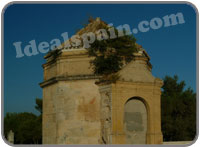 |
|
At the
front,
the
wrought-iron
gate
is an
important
work
made
about
1700.
Inside
this
fenced
area
we
find
two
"twinned"
altarpieces
of a
Solomonic
order.
Stylistically
they
are
related
to the
main
altarpiece.
In the
Gospel
side
we
find
the
Blessed
Virgin
(la
Inmaculada),
a work
of the
Sevillian
School.
In the
Epistle
side
we
find
Saint
Joseph
holding
the
Baby
Jesus.
The
cloister
has
wonderful
sculptures
like
the
one of
Our
Lady
of "El
Rosario"
(1620),
the
"Ecce
Homo"
(1650),
"Santa
Catalina
de
Alejandría",
and
different
sculptures
of the
Baby
Jesus
(18th
and
19th
centuries).
Its
most
remarkable
sculptures,
however,
are
"San
Joaquín"
and a
Crucified
Christ
by
Luis
Salvador
Carmona.
Among
the
gold
and
silver
articles
we can
highlight
an
Italian
reliquary
from
the
end of
the
16th
century
and
two
Monstrances,
one
dating
from
the
end of
the
16th
century
and
one
dating
from
the
first
quarter
of the
17th
century
with a
chalice
matching
it.
The
main
altarpiece
was
built
with
the
money
that
the
king
Charles
V owed
to the
marquis
who
granted
this
money
(when
paid)
to the
convent.
The
altarpiece
was
built
with
this
money
two
hundred
years
later.
In the
same
area
you
will
find
several
other
important
buildings
and
the
remains
of the
old
city
walls
that
encircle
the
hilltop.
The
ruins
are
visible
from
miles
around. |
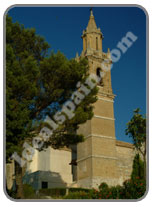 |
|
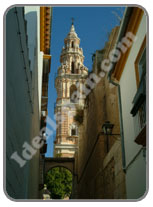 |
Church
of Del
Carmen
In
1745
the
fraternity
"Rosario
del
Carmen"
bought
the
houses
near
the
temple
to
build
the
square
known
today
as "Ntra.
Sra.
Del
Carmen"
where
bull-fighting
events
took
place
at the
time.
According
to the
tradition
and
Carmelite
belief,
Our
lady
gave a
scapulary
to St.
Simon
Stock
with
the
promise
that
anyone
wearing
the
Carmelite
habit
and
carrying
the
scapulary
would
enjoy
eternal
life.
Our
Lady
of
Carmelo
is the
protector
of
fishermen
and
sailors
since
ancient
times.
The
main
facade
of the
church
was
finished
in
1768
and is
one of
the
most
emblematic
portals
from
the
Andalusia
Baroque
of the
17th
century.
Plated-pieces
of
white
and
black
marble
are
combined
as a
magnificent
display.
The
plan
and
raise
of the
main
front
show
marked
dynamism
and
overawed
theatrical
effect.
Several
Gothic-Mudejar
pillars
with
mix-lined
sections,
probably
remaining
from a
previous
building,
stand
on one
side.
The
structure
of
tower
chapel
of the
entrance
of
this
church
is
also
found
in
other
temples,
Ntra.
Sra.
de la
Asunción"
and "Ntra.
Sra.
de los
Remedios".
This
typical
architecture
is
pointed
up as
one of
the
spaces
more
unique
in the
Andalucian
baroque
from
the
18th
century. |
Church
of Sra
de los
Remedios
This
wonderful
church
is
located
in
Plaza
de los
Remedios.
Through
the
centuries,
this
primitive
hermitage
and
latter
church
has
suffered
different
fates,
including
periods
of
decadence
(end
of
16th
and
17th
centuries)
when
it was
used
even
as
accommodation
for
the
soldiers
that
passed
by.
These
dark
times
were
broken
by the
cultural
Baroque
lightening
of the
18th
century,
becoming
a
jewel
for
the
city
at
that
time.
In
1994 a
second
refurbishing
was
needed,
concluding
in
1999.
Two
different
parts
can be
appreciated:
on one
hand,
the
set of
domes
topping
the "camarín"
and
sanctuary
and on
the
other,
the
nave
and
detached
chapels
located
both
sides
and
covered
by a
two
sided
roof.
The
lateral
walls
present
irregular
aspect
due to
the
side
chapels,
placed
between
the
buttresses
that
were
added
progressively
through
the
19th
century.
Pictured
right
is
part
of the
detail.
|
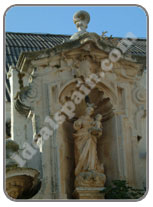 |
|
San
Sebastian
Church
There
was a
hermitage
of San
Sebastian
in the
16th
Century
that
later
achieved
the
category
of
church.
On the
13th
of
January,
1541,
the
Spanish
King
Charles
I, as
administrator
of the
Santiago
Military
Order,
ordered
that
in
Estepa
there
were
to be
two
parishes:
Santa
María
and
San
Sebastian,
linked
to the
basilica
of
Saint
John
of
Letran
in
Rome
by a
Pontifical
bull.
The
ancient
church
had
only
one
nave
and
due to
the
deficient
maintenance
it was
rebuilt
in
1568
according
to the
guidelines
of the
Genoese
architect
Vicente
Boyol.
This
architect
arrived
here
thanks
to the
Marquis
of
Estepa
(born
in
Genoa).
The
plans
of the
church
were
approved
in
1575.
The
church
is
located
between
the
squares
of San
Sebastian
and
Ntro.
Padre
Jesús.
It has
two
fronts:
the
main
door,
situated
in
Ntro
Padre
Jesus
Square,
is
Renaissance
style.
It is
flanked
by two
large
buttresses.
The
church
is
shaded
by
beautiful
trees.
|
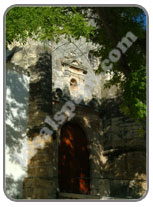 |
Gastronomy
and
fiestas
Local
dishes
like "Migas,
Salmorejo,
Olla,
Revuelto
de
Espárragos
and
Potaje"
are
good
culinary
reasons
to
visit
Estepa.
You
will
also
find a
wide
variety
of
sweets,
home
made
desserts
or
made
by the
delicate
hands
of the
nuns
in our
convents.
Usually
the
different
kind
sweets
and
desserts
are
associated
with
agricultural
and
festive
cycles.
During
February
Estepa
celebrates
the
carnival,
where
masks,
customs
and
satiric
songs
combine
with
processions.
On the
1st of
May
Estepa
celebrates
the
Romería
de San
José
Obrero.
The
pilgrims,
almost
everyone
in the
town,
adorn
chariots
and go
to the
Hermitage
of
Santa
Ana,
more
precisely
to a
place
known
as "Manantial
de
Roya".
On the
3rd
Sunday
of May
the "Octava
de los
Remedios"
has
its
turn
in
Roya
Street.
Our
Lady
of
"Los
Remedios"
is the
patron
of the
neighbourhood
known
popularly
as "Churretero".
About
26th
of
July
"La
Velá
de
Santa
Ana"
has
been
celebrated
since
at
least
the
18th
century
in the
neighbourhood
of "La
Coracha".
Honouring
our
patron,
Our
Lady
of "La
Asuncion"
the
fair
of
Estepa
takes
place
on the
15th
of
August.
People
enjoy
sherry,
ride
Andalusian
horses
and
dance
our
famous
"sevillanas".
On the
2nd of
February
Estepa
celebrates
the
fête
of "La
Candelaria".
Traditionally,
friends
and
neighbours
get
together
to
make
large
bonfires
and
enjoy
the
company
and
the
heat
of the
fires
during
that
night.
The
3rd of
February
is
"San
Blas"
onomastic.
The
children
take
their
medals
and
cakes
to the
church
to be
blessed.
Since
the
18th
century,
Our
Lady
of
Carmel
is
taken
in
procession
on the
12th
of
September.
The
parishioners
accompany
Our
Lady
carrying
torches
and
flares
through
La
Puente
Street.
|
|
|
|
|
Estepa
is
fortunate
in one
respect
that
is has
a
constant
free
supply
of
fresh
spring
water.
The
spring
originates
within
the
Hotel
Manantial
de
Roya,
on the
outskirts
of the
town.
Just
outside
the
hotel
is an
outlet
where
a
constant
stream
of
people
fill
their
water
containers
with
fresh
water.
|
Our
visit
to
Estepa
Being
just
one
hour
from
Malaga
and
thirty
minutes
from
Antequera,
Estepa
is an
easy
visit
for a
day.
We
stayed
overnight
and
explored
the
town
within
a
couple
of
hours.
The
people
of
Estepa
made
us
very
welcome.
Although
a
busy,
thriving
town
with
its
own
industries,
the
town
was
very
quiet.
The
surrounding
countryside
is
beautiful
yet in
the
summer
is
unbearably
hot.
The
religious
importance
of
Estepa
is
evident
by the
number
of
churches
and
the
naming
of the
streets.
Estepa
is a
very
clean
place
and
the
local
residents
take
great
pride
in
their
surroundings. |
|
The
Town
Hall
of
Estepa
is
located
in
Avda.
Badía
Polesine,
28
(next
to
Oficina
del
INEM).
Telephone
+34
955
912
717.
The
Town
Council
website |
| |
|
|
| |
|
| |
|
|
|

